Milwaukee M18 Fuel Super Hawg 2711-22 Handleiding
Milwaukee
Boormachine
M18 Fuel Super Hawg 2711-22
Bekijk gratis de handleiding van Milwaukee M18 Fuel Super Hawg 2711-22 (13 pagina’s), behorend tot de categorie Boormachine. Deze gids werd als nuttig beoordeeld door 43 mensen en kreeg gemiddeld 4.9 sterren uit 22 reviews. Heb je een vraag over Milwaukee M18 Fuel Super Hawg 2711-22 of wil je andere gebruikers van dit product iets vragen? Stel een vraag
Pagina 1/13

OPERATOR'S MANUAL
MANUEL de L'UTILISATEUR
MANUAL del OPERADOR
Cat. No.
No de cat.
2709-20
2711-20
M18™ FUEL™ SUPER HAWG™ RIGHT ANGLE DRILLS
PERCEUSE SUPER HAWG™ M18™ FUEL™ DE ÉLECTRICIEN
TALADRO SUPER HAWG™ DE M18™ FUEL™ PARA ELECTRICISTAS
TO REDUCE THE RISK OF INJURY, USER MUST READ AND UNDERSTAND OPERATOR'S
MANUAL.
AFIN DE RÉDUIRE LE RISQUE DE BLESSURES, L'UTILISATEUR DOIT LIRE ET BIEN
COMPRENDRE LE MANUEL DE L'UTILISATEUR.
PARA REDUCIR EL RIESGO DE LESIONES, EL USUARIO DEBE LEER Y ENTENDER EL
MANUAL DEL OPERADOR.

23
BATTERY TOOL USE AND CARE
PERSONAL SAFETY
GENERAL POWER TOOL SAFETY WARNINGS
WORK AREA SAFETY
ELECTRICAL SAFETY
POWER TOOL USE AND CARE
• Keep work area clean and well lit. Cluttered or
dark areas invite accidents.
• Do not operate power tools in explosive atmos-
pheres, such as in the presence of fl ammable
liquids, gases or dust. Power tools create sparks
which may ignite the dust or fumes.
• Keep children and bystanders away while op-
erating a power tool. Distractions can cause you
to lose control.
• Power tool plugs must match the outlet. Never
modify the plug in any way. Do not use any
adapter plugs with earthed (grounded) power
tools. Unmodifi ed plugs and matching outlets will
reduce risk of electric shock.
• Avoid body contact with earthed or grounded
surfaces, such as pipes, radiators, ranges and
refrigerators. There is an increased risk of electric
shock if your body is earthed or grounded.
• Do not expose power tools to rain or wet condi-
tions. Water entering a power tool will increase the
risk of electric shock.
• Do not abuse the cord. Never use the cord for
carrying, pulling or unplugging the power tool.
Keep cord away from heat, oil, sharp edges
or moving parts. Damaged or entangled cords
increase the risk of electric shock.
• When operating a power tool outdoors, use an
extension cord suitable for outdoor use. Use of
a cord suitable for outdoor use reduces the risk of
electric shock.
• If operating a power tool in a damp location is
unavoidable, use a ground fault circuit inter-
rupter (GFCI) protected supply. Use of an GFCI
reduces the risk of electric shock.
• Stay alert, watch what you are doing and use
common sense when operating a power tool. Do
not use a power tool while you are tired or under
the infl
uence of drugs, alcohol or medication.
A
moment of inattention while operating power tools
may result in serious personal injury.
• Use personal protective equipment. Always
wear eye protection. Protective equipment such
as a dust mask, non-skid safety shoes, hard hat or
hearing protection used for appropriate conditions
will reduce personal injuries.
• Prevent unintentional starting. Ensure the
switch is in the o-position before connecting
to power source and/or battery pack, picking
up or carrying the tool. Carrying power tools with
your fi nger on the switch or energizing power tools
that have the switch on invites accidents.
• Remove any adjusting key or wrench before
turning the power tool on. A wrench or a key left
attached to a rotating part of the power tool may
result in personal injury.
• Do not overreach. Keep proper footing and bal-
ance at all times. This enables better control of the
power tool in unexpected situations.
• Dress properly. Do not wear loose clothing or
jewelry. Keep your hair and clothing away from
moving parts. Loose clothes, jewelry or long hair
can be caught in moving parts.
• If devices are provided for the connection of
dust extraction and collection facilities, ensure
these are connected and properly used. Use of
dust collection can reduce dust-related hazards.
• Do not let familiarity gained from frequent use of
tools allow you to become complacent and ig-
nore tool safety principles. A careless action can
cause severe injury within a fraction of a second.
• Do not force the power tool. Use the correct
power tool for your application. The correct
power tool will do the job better and safer at the
rate for which it was designed.
• Do not use the power tool if the switch does not
turn it on and o. Any power tool that cannot be
controlled with the switch is dangerous and must
be repaired.
• Disconnect the plug from the power source and/
or remove the battery pack, if detachable, from
the power tool before making any adjustments,
changing accessories, or storing power tools.
Such preventive safety measures reduce the risk
of starting the power tool accidentally.
• Store idle power tools out of the reach of chil-
dren and do not allow persons unfamiliar with
the power tool or these instructions to operate
the power tool. Power tools are dangerous in the
hands of untrained users.
• Maintain power tools and accessories. Check
for misalignment or binding of moving parts,
breakage of parts and any other condition that
may aect the power tool’s operation. If dam-
aged, have the power tool repaired before use.
Many accidents are caused by poorly maintained
power tools.
• Keep cutting tools sharp and clean. Properly
maintained cutting tools with sharp cutting edges
are less likely to bind and are easier to control.
• Use the power tool, accessories and tool bits
etc. in accordance with these instructions, tak-
ing into account the working conditions and
the work to be performed. Use of the power tool
for operations dierent from those intended could
result in a hazardous situation.
• Keep handles and grasping surfaces dry, clean
and free from oil and grease. Slippery handles
and grasping surfaces do not allow for safe handling
and control of the tool in unexpected situations.
• Recharge only with the charger specifi ed by the
manufacturer. A charger that is suitable for one
WARNING Read all safety warnings, instructions, illustrations and specifi cations provided
with this power tool. Failure to follow all instructions listed below may result in electric shock, fi re
and/or serious injury. Save all warnings and instructions for future reference. The term "power tool" in
the warnings refers to your mains-operated (corded) power tool or battery-operated (cordless) power tool.
FUNCTIONAL DESCRIPTION
• Use auxiliary handle(s), if supplied with the
tool. Loss of control can cause personal injury.
• Hold power tool by insulated gripping surfaces,
when performing an operation where the cutting
accessory may contact hidden wiring. Cutting
accessory contacting a “live” wire may make
exposed metal parts of the power tool “live” and
could give the operator an electric shock.
• Maintain labels and nameplates. These carry
important information. If unreadable or missing,
contact a MILWAUKEE service facility for a free
replacement.
• WARNING Some dust created by power sanding,
sawing, grinding, drilling, and other construction
activities contains chemicals known to cause
cancer, birth defects or other reproductive harm.
SPECIFIC SAFETY RULES
SYMBOLOGY
Volts
Direct Current
No Load Revolutions
per Minute (RPM)
C US Underwriters Laboratories, Inc.
United States and Canada
1. Top handle
2. Keyed chuck 1/2"
(Cat. No. 2709-20)
3. Shift knob
4. Side handle
5. LED
6. Chuck key storage
7. Main handle
8. Trigger
9. Control switch
10. 7/16" QUIK-LOK™ Hex chuck (Cat. No. 2711-20)
5
1
26
8
10
4
9 7
SERVICE
type of battery pack may create a risk of fi re when
used with another battery pack.
• Use power tools only with specifi cally desig-
nated battery packs. Use of any other battery
packs may create a risk of injury and fi re.
• When battery pack is not in use, keep it away
from other metal objects, like paper clips, coins,
keys, nails, screws or other small metal objects,
that can make a connection from one terminal
to another. Shorting the battery terminals together
may cause burns or a fi re.
• Under abusive conditions, liquid may be ejected
from the battery; avoid contact. If contact ac-
cidentally occurs, fl ush with water. If liquid con-
tacts eyes, additionally seek medical help. Liquid
ejected from the battery may cause irritation or burns.
• Do not use a battery pack or tool that is dam-
aged or modifi ed. Damaged or modifi ed batteries
may exhibit unpredictable behavior resulting in fi re,
explosion or risk of injury.
• Do not expose a battery pack or tool to fi re
or excessive temperature. Exposure to fi re or
temperature above 265°F (130°C) may cause
explosion.
• Follow all charging instructions and do not
charge the battery pack or tool outside the
temperature range specifi ed in the instructions.
Charging improperly or at temperatures outside
the specifi ed range may damage the battery and
increase the risk of fi re.
• Have your power tool serviced by a qualifi ed
repair person using only identical replacement
parts. This will ensure that the safety of the power
tool is maintained.
• Never service damaged battery packs. Service
of battery packs should only be performed by the
manufacturer or authorized service providers.
Some examples of these chemicals are:
• lead from lead-based paint
• crystalline silica from bricks and cement and
other masonry products, and
• arsenic and chromium from chemically-treated
lumber.
Your risk from these exposures varies, depending
on how often you do this type of work. To reduce
your exposure to these chemicals: work in a well
ventilated area, and work with approved safety
equipment, such as those dust masks that are spe-
cially designed to fi lter out microscopic particles.
3

45
SPECIFICATIONS
Volts
DC
18
Cat. No.
2709-20/2711-20
Selfeed
Bit
2-9/16"
4-5/8"
Auger
Bit
1-1/2"
1-1/2"
Twist
Bit
5/16"
1/2"
Ship Auger
Bit
1-1/2"
1-1/2"
Hole
Saw
4"
6"
Steel Wood
Capacity
ASSEMBLY
WARNING Recharge only with the
charger specifi ed for the battery. For specifi c
charging instructions, read the operator’s
manual supplied with your charger and battery.
Inserting/Removing the Battery
To remove the battery, push in the release buttons
and pull the battery pack away from the tool.
To insert the battery, slide the pack into the body of
the tool. Make sure it latches securely into place.
Bit Selection
• Use sharp bits. Sharp bits are less likely to bind
when drilling.
• Use the proper bit for the job. There are many
types of bits designed for specifi c purposes. Check
the information on the bit's packaging for proper
usage.
• Do not use bits larger than the rated capacity of
the drill. Gear damage or motor overload may
result (see "Specifi cations").
Installing Bits
Always remove the battery before inserting or
removing bits. Select the proper style and size bit
for the application.
WARNING Always remove battery
pack before changing or removing acces-
sories. Only use accessories specifically
recommended for this tool. Others may be
hazardous.
Installing Bits into Keyed Chucks
(Cat. No 2709-20)
1. Remove the battery pack.
2. Open the chuck jaws wide
enough to insert the bit. Be
sure the bit shank and chuck
jaws are clean. Dirt particles
may prevent the bit from lin-
ing up properly.
3. Insert the bit into the chuck. Center the bit in the
chuck jaws and lift it about off of the bottom. 1/16"
Tighten the chuck jaws by hand to align the bit.
4. Place the chuck key in each of the three holes
in the chuck, turning it clockwise to tighten the
chuck securely.
NOTE: Never use a wrench or means other than
a chuck key to tighten or loosen the chuck.
5. To remove the bit, insert the chuck key into
one of the holes in the chuck and turn it coun-
terclockwise.
Installing Bits into QUIK-LOK™ Hex 7/16"
Chuck (Cat. No 2711-20)
1. Remove the battery pack.
2. To attach an accessory, press the shank into the
hex drive chuck.
3. To remove the accessory, pull out the ring and
remove the accessory. Release the ring.
Side Handle
The side handle can be installed on either side of
the tool. To install the side handle, thread it into the
socket on the desired side of the tool and tighten
it securely.
OPERATION
WARNING Always remove battery
pack before changing or removing acces-
sories. Only use accessories specifically
recommended for this tool. Others may be
hazardous.
Bit binding
If the bit binds, the drill will suddenly react in the
opposite direction of the rotation of the bit. Reduce
the chances of a sudden reaction by following the
instructions listed below. Prepare for a sudden
reaction by holding or bracing securely.
To reduce the chance of bit binding:
• Use sharp bits. Sharp bits are less likely to bind
when drilling.
• Use the proper bit for the job. There are many
types of bits designed for specifi c purposes.
• Keep selfeed bits aligned with the work surface
so bits go in straight (see "Drilling").
• Avoid drilling warped, wet, knotty, and/or pitchy
material if possible.
• Avoid drilling in material that you suspect contains
hidden nails or other things that may cause the bit
to bind.
The direction of reaction is always opposite of the
direction of bit rotation. Reaction is even more likely
to occur when enlarging already existing holes and
at the point when the bit breaks through the other
side of the material.
If the bit does bind:
1. Release the trigger immediately.
2. Reverse the motor.
3. Remove the bit from the work and start again.
4. Do not pull the trigger on and o to attempt to
start a stalled bit. This will damage the drill.
WARNING To reduce the risk of injury,
wear safety goggles or glasses with side
shields.
WARNING To reduce the risk of per-
sonal injury when drilling, hold the tool by isu-
lated gripping surfaces when performing an
operation where the cutting tool may contact
hidden wiring. Contact with a "live" wire will
make exposed metal parts of the tool "live"
and shock the operator
WARNING To reduce the risk of injury,
hold or brace securely. Always be prepared
for bit binding and drill reaction.
A
B
D
Bracing for forward rotation
When drilling in forward, the bit will rotate in a
clockwise direction. If the bit binds in the hole, the
bit will come to a sudden stop and drill will suddenly
react in a counterclockwise direction.
The following fi gures show examples of properly
bracing the tool for forward rotation.
A. Forward (clockwise) rotation
B. Reaction
C. Brace drill with motor housing here
D. Brace drill with side handle here
If the bit binds, the motor housing braced against
the stud will hold the drill in position.
A
B
C
No Load RPM
High 0 - 950
Low 0 - 350
Product specificaties
| Merk: | Milwaukee |
| Categorie: | Boormachine |
| Model: | M18 Fuel Super Hawg 2711-22 |
Heb je hulp nodig?
Als je hulp nodig hebt met Milwaukee M18 Fuel Super Hawg 2711-22 stel dan hieronder een vraag en andere gebruikers zullen je antwoorden
Handleiding Boormachine Milwaukee
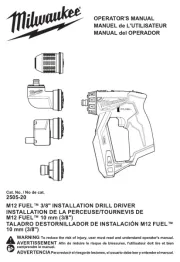
19 Augustus 2025
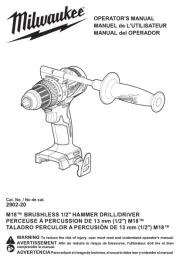
19 Augustus 2025
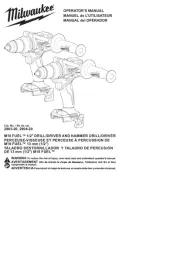
19 Augustus 2025
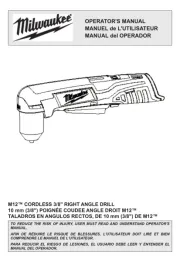
19 Augustus 2025
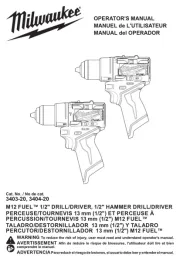
19 Augustus 2025
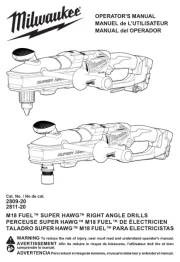
18 Augustus 2025
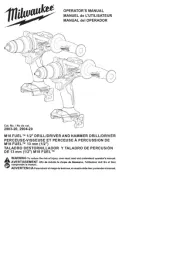
18 Augustus 2025
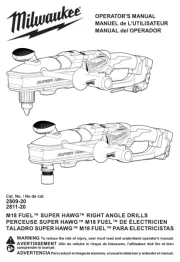
18 Augustus 2025
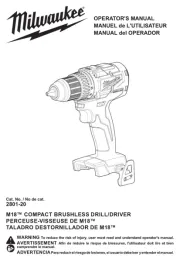
18 Augustus 2025
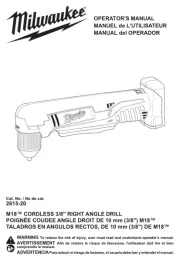
18 Augustus 2025
Handleiding Boormachine
- NEO Tools
- Festo
- Proxxon
- Ryobi
- Netter Vibration
- Bruder Mannesmann
- Batavia
- Einhell Bavaria
- Total
- RUKO
- Cotech
- Stomer
- Economy
- Herkules
- Bavaria
Nieuwste handleidingen voor Boormachine
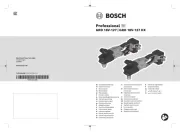
16 September 2025
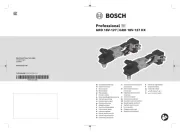
16 September 2025
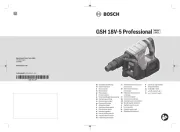
15 September 2025
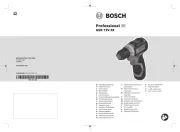
15 September 2025
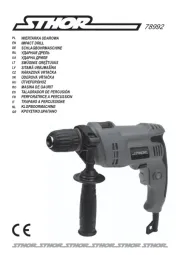
13 September 2025
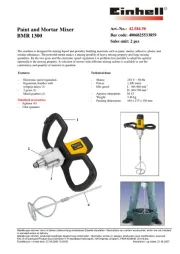
13 September 2025
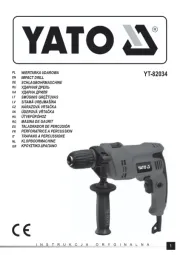
12 September 2025
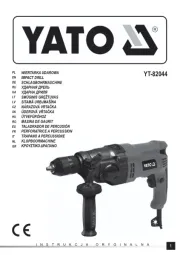
12 September 2025
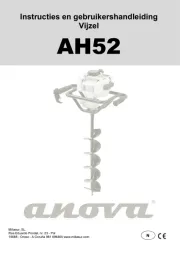
9 September 2025
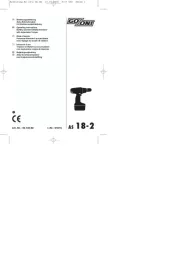
8 September 2025